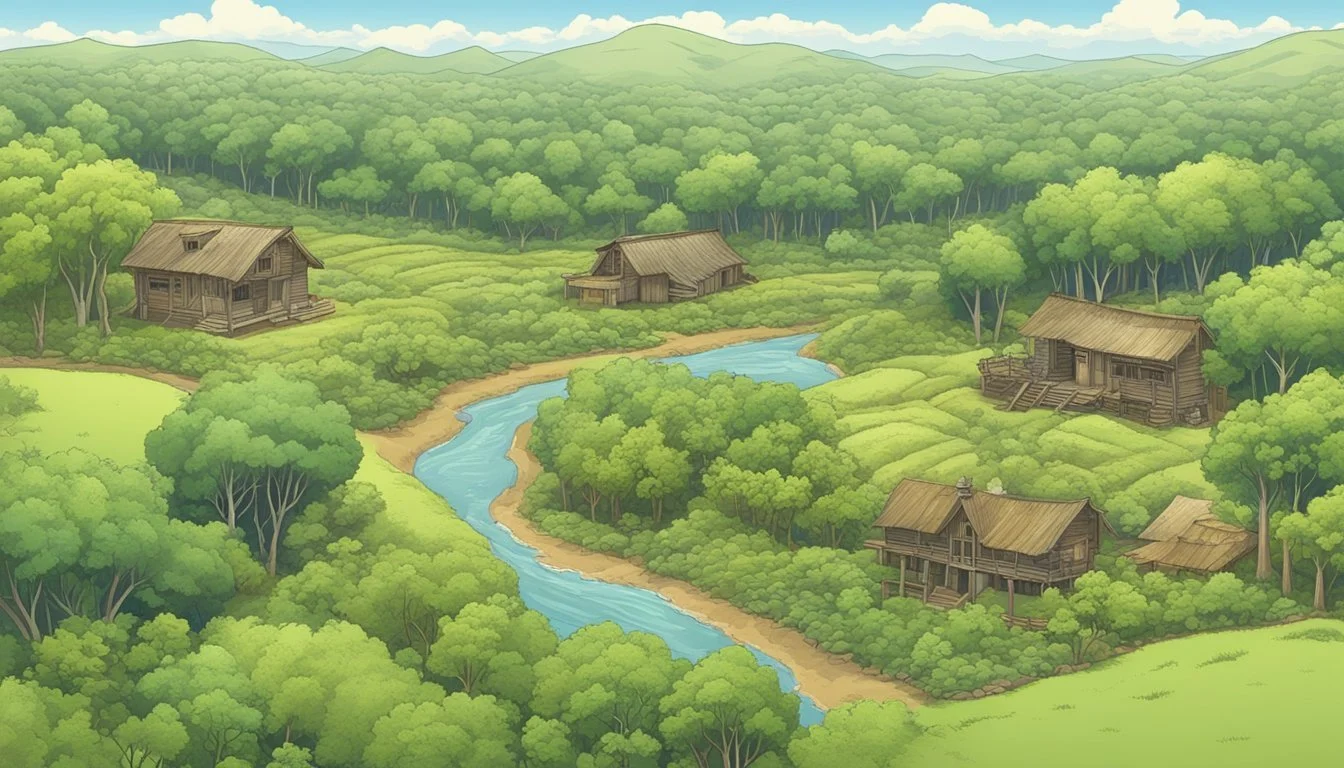Environmental Impact of Free Land Programs
Assessing Long-Term Consequences
Free land programs have emerged across various states and countries as innovative solutions to stimulate development and promote environmental sustainability. For example, initiatives like the "Adopt-a-Lot" program allow individuals and communities to acquire vacant urban land for free, paving the way for new farming opportunities and urban greening projects.
These programs not only provide economic benefits but also significantly contribute to environmental conservation. By transforming abandoned or underutilized land into thriving green spaces, they help sequester carbon, reduce urban heat islands, and improve biodiversity. The adoption of sustainable farming and forestry practices on these lands further enhances soil health and combats climate change.
In Niger, similar endeavors have demonstrated remarkable success. Rural communities transformed 7,200 hectares of once-abandoned land into productive forests, earning substantial carbon credit payments while rejuvenating the local ecosystem. Such examples illustrate the positive environmental impact of free land programs and their potential to drive both ecological and economic development.
Historical Context of Land Allocation
The allocation of land has historically played a crucial role in shaping both environmental and economic outcomes. Key moments, such as the Homestead Act, have left an enduring legacy on land management and development.
Homestead Act and Its Legacy
The Homestead Act of 1862 was a landmark in U.S. history, offering free land to settlers as long as they resided and cultivated the land for five years. This act facilitated the allocation of approximately 10% of U.S. land to 1.6 million individuals.
This massive allocation catalyzed Western expansion and significantly influenced agricultural practices and economic development. It promoted small-scale farming but also led to significant environmental changes, such as deforestation and soil depletion, as vast tracts of wilderness were converted to agricultural land.
Development of Free Land Programs
Free land programs have evolved around the world, often aimed at mitigating historical inequalities in land distribution. These programs aim to correct historical injustices and improve land use efficiency. Examples include land reforms in post-colonial states and the redistribution initiatives in post-Soviet countries.
Such programs often include federally subsidized crop insurance and initiatives like the Conservation Reserve Program (CRP), which seeks to balance agricultural productivity with environmental sustainability. These programs not only aim to uplift economically marginalized communities but also strive to mitigate environmental degradation.
Successful implementation requires balancing economic development with sustainable land management practices, highlighting the complexities of modern land allocation policies.
Understanding Environmental Impact
Environmental impact refers to the various effects that projects, actions, or legislative measures have on the natural surroundings, encompassing physical, chemical, biological, cultural, and socioeconomic factors.
Defining Environmental Impact
Environmental impact can be seen as the changes brought about by human activities on the environment. This encompasses emissions, resource depletion, and the alteration of ecosystems. According to Hauschild (2018) and Sanchéz (2006), the term often implies negative consequences, such as habitat destruction or pollution, leading to shifts in public opinion.
For effective analysis, environmental impact assessments are crucial. These assessments systematically identify and evaluate potential impacts, helping inform decision-making processes. The primary goal is to predict and mitigate adverse effects, ensuring a balance between development and conservation.
Metrics and Indicators
Metrics and indicators play a pivotal role in evaluating environmental impact. Common indicators include emission levels, biodiversity loss, water quality, and land use changes. These metrics provide quantifiable data that can guide policies and practices toward sustainability.
The Environmental Protection Agency (EPA) employs various methodologies to assess impacts. These methods involve both theoretical frameworks and empirical data, aiming to measure benefits and costs accurately. Effective metrics facilitate the development of strategies to minimize negative impacts while promoting sustainable practices.
Role of Environmental Protection Agencies
Environmental protection agencies enforce guidelines and collaborate with state and local governments to maintain and restore environmental quality. Their role is crucial in ensuring public health and the sustainability of ecosystems.
EPA Guidelines and Involvement
The Environmental Protection Agency (EPA) is central to environmental protection in the United States. It establishes and enforces regulations based on scientific research to minimize environmental risks.
The EPA sets limits on air pollutants from various sources like factories, power plants, and vehicles. Clean air standards protect public health by reducing respiratory problems and other health issues.
Additionally, the EPA manages water quality standards to prevent pollution in lakes, rivers, and groundwater. They also enforce federal laws, ensuring compliance through inspections and penalties. Grants and funding provided by the EPA support state and local programs aimed at environmental protection.
Local and State Contributions
State and local governments play a significant role in the day-to-day implementation of environmental policies. They adapt federal guidelines to fit regional needs and challenges.
State agencies handle issues like waste management, wildlife conservation, and pollution control. They often work closely with the EPA, receiving technical support and funding.
Local governments engage in community-specific projects such as green city initiatives and public awareness campaigns. Collaboration between local, state, and federal entities ensures comprehensive environmental protection, combining resources and expertise. These levels of government work synergistically to address environmental concerns effectively and efficiently.
Land Programs and Ecosystem Conservation
Free land programs play a significant role in conserving ecosystems and preserving biodiversity by implementing targeted initiatives. They aim to restore habitats, protect wildlife, and ensure the sustainability of natural resources for future generations.
Impact on Biodiversity and Habitats
Land conservation programs provide crucial benefits to biodiversity and habitats. By setting aside land for conservation, these programs create safe havens for endangered and threatened species, allowing their populations to recover. Restored areas also improve habitat quality, fostering a diversity of flora and fauna.
These conserved lands effectively reduce threats such as habitat destruction, pollution, and invasive species. Protecting vast tracts of land helps maintain ecological processes crucial for wildlife. Such protections are essential in buffering ecosystems from the impacts of climate change, ensuring they remain resilient and capable of supporting diverse life forms.
Restoration Initiatives
Restoration initiatives under free land programs focus on rehabilitating degraded ecosystems. These efforts often include reforestation, wetland restoration, and soil erosion control. Reforestation helps sequester carbon, mitigate climate change impacts, and provides critical habitat for many species.
Wetland restoration improves water quality, supports fish and bird populations, and enhances flood control. By addressing soil erosion, these programs boost agricultural productivity and prevent sedimentation in waterways, benefiting both ecosystems and human activities.
Collaborations with local communities and stakeholders are integral to the success of these initiatives. Involving them in restoration efforts ensures sustainable practices and fosters a sense of stewardship over the land, furthering long-term conservation goals.
Economic Aspects of Land Programs
Free land programs offer various economic benefits, impacting both broader economies and specific local or indigenous communities. The sections below explore these aspects in detail.
Free Land and Economic Benefits
Free land initiatives can drive economic growth. By providing land at no cost, these programs can attract new residents and businesses, stimulating economic activity. This often leads to increased demand for goods and services, which can create jobs and boost local economies.
Investors and start-ups may find these programs appealing as they lower initial costs, enabling them to allocate resources towards business development. This can lead to innovation and diversification in the local economy. Additionally, property values may increase due to the influx of new activities, benefiting current landowners.
Impact on Local and Indigenous Economies
Free land programs can profoundly affect local and indigenous economies. For local communities, these programs may result in revitalized areas through improved infrastructure and services. Increased population and business activities can lead to higher tax revenues, which can be reinvested into public services.
For indigenous peoples, these programs have complex implications. While there are potential benefits such as job creation and improved living standards, there are also risks. The introduction of new populations and businesses might disrupt traditional ways of life and lead to land disputes. It’s vital to incorporate indigenous voices in planning and ensure their rights and traditions are respected.
Combining economic growth with sustainable practices and cultural sensitivity can make free land programs a successful tool for both development and preservation.
Community and Health Benefits
Free land programs have the potential to significantly enhance human health and foster sustainable living, which in turn supports food security within local communities. They facilitate improved living conditions and healthier environments.
Improving Local Communities' Health
Free land programs enable the development of green spaces and community parks that can substantially benefit physical and mental well-being. Parks and recreational areas promote physical activity, reduce obesity, and lower the risk of chronic diseases. Moreover, these spaces serve as social hubs, fostering community bonds and reducing stress. Enhancements in local infrastructure resulting from these programs can also ensure better air and water quality, contributing to overall human health.
Sustainable Living and Food Security
Through free land programs, communities are empowered to pursue sustainable living practices such as urban agriculture and community gardening. This promotes food security by providing accessible fresh produce and reducing reliance on external food sources. Land is also used for sustainable housing projects that prioritize energy efficiency and eco-friendly designs. These initiatives contribute to environmental health and sustainable community development, creating a self-sufficient and resilient local food system.
Land Programs: Policies and Procedures
Land programs offering free land come with specific policies and regulations. Understanding these aspects ensures compliance and smooth application.
Application Process for Free Land
The application process for free land programs typically involves several steps. First, applicants must meet specific eligibility criteria, often related to residency, age, or agricultural experience. Once eligibility is confirmed, applicants must fill out a comprehensive application form, providing detailed information about their plans for the land and their financial capability to develop it.
Applicants may also need to submit supplementary documents such as proof of identity, financial statements, and a development plan. Many programs also require applicants to participate in an interview or attend an informational session. It is crucial for applicants to strictly adhere to the guidelines and deadlines set by the program administrators to enhance their chances of approval.
Regulations and Legal Easements
Free land programs are governed by regulations to ensure sustainable land use and compliance with environmental laws. These regulations often require beneficiaries to use the land for specific purposes, such as agriculture or conservation. Beneficiaries must comply with local and federal environmental regulations to maintain the integrity of their land grants.
Legal easements often accompany these programs. Easements can stipulate how the land can and cannot be used, preserving certain rights for public access or conservation efforts. For instance, a conservation easement might restrict development to maintain the land’s natural state. Understanding and adhering to these easements and regulations is vital for participants to avoid legal complications and retain their rights to the land.
Environmental and Climate Considerations
Evaluating the environmental and climate considerations of free land programs is essential. Critical aspects to examine include the impact of land use on climate change and the strategies to reduce greenhouse gas emissions.
Climate Change and Land Use
Land use decisions play a crucial role in mitigating or exacerbating climate change. Urban expansion, deforestation, and agricultural practices are primary drivers of greenhouse gas emissions associated with land use. Smart land use planning can reduce emissions by maintaining natural carbon sinks, such as forests, and promoting sustainable agricultural practices. Integrated land use planning is vital to balance economic development with environmental protection, ensuring that future projects do not compromise climate resilience.
Reducing Greenhouse Gas Emissions
Efforts to reduce greenhouse gas emissions in the context of free land programs must prioritize energy efficiency and the adoption of renewable energy sources. Retrofitting buildings with energy-efficient technologies, promoting public transportation, and supporting local renewable energy projects can significantly lower emissions. Policies encouraging green building standards and sustainable infrastructure development are essential to achieve long-term reductions. Additionally, enforcing stricter environmental impact assessments (EIAs) for new projects ensures that all developments consider and mitigate potential contributions to climate change.
Case Studies and Success Stories
Free land programs have seen varied success across different states, particularly in Texas, which offers a significant insight into program effectiveness. Additionally, firsthand testimonials and robust program outreach efforts underscore the impact and public perception of these initiatives.
Program Effectiveness in Texas and Beyond
Texas has been a focal point for free land programs, utilizing them to revitalize rural areas. Community leaders report increased population growth and economic activity as a direct result of these initiatives.
For example, cities in the Texas Panhandle offered parcels of land to attract new residents, successfully boosting local businesses and schools. Moreover, the model has inspired similar programs in states like Kansas and Nebraska, demonstrating the potential for widespread application.
Testimonials and Program Outreach
Participants often highlight the personal and economic benefits of free land programs. Residents have shared stories of how these initiatives enabled them to build homes, start businesses, and integrate into new communities. This feedback is crucial for continuous improvement and encourages other regions to adopt similar strategies.
In terms of outreach, many programs organize community events and leverage social media to reach potential participants nationwide. Effective communication strategies ensure that the programs are well-publicized and accessible, attracting a diverse group of applicants interested in these opportunities.
Strategic Partnerships for Environmental Goals
Strategic partnerships play a crucial role in achieving environmental targets, leveraging the strengths of various stakeholders to drive sustainable initiatives effectively. Collaborations between non-profit organizations and funding coupled with technical support are central to these efforts.
Collaborations with Non-Profit Organizations
Non-profit organizations frequently work with governmental agencies to advance environmental goals. For example, the U.S. Environmental Protection Agency (EPA) partners with diverse non-profits to foster equitable development and sustainable communities. These partnerships facilitate joint efforts and knowledge sharing.
Non-profits often bring specialized expertise and community connections, enhancing outreach and engagement. An example includes partnerships in Brownfields redevelopment, where non-profits assist in repurposing contaminated land, contributing to clean air and water goals. These collaborations result in practical solutions that balance economic, social, and environmental objectives, ensuring more effective implementation of programs.
Funding and Technical Support
Funding and technical support are crucial in driving environmental initiatives. The EPA, for instance, provides technical assistance to communities through programs like Building Blocks for Sustainable Communities. This support helps localities design and implement sustainable development strategies, addressing specific environmental challenges.
Grants and funding opportunities are available to non-profits and community organizations, ensuring they have the resources to execute projects successfully. By combining financial resources with technical expertise, these programs enhance the capacity of local initiatives, leading to more substantial and lasting impacts. This synergy is essential for addressing complex environmental issues comprehensively and sustainably.
Challenges and Considerations
In implementing free land programs, significant challenges exist in minimizing negative environmental impacts and ensuring the long-term sustainability of these opportunities. Proper planning is essential to balance economic growth with environmental stewardship.
Minimizing Negative Impacts
Properly managing free land siting is key to avoid damaging ecosystems. Selection criteria must consider biodiversity and wildlife habitats. Environmental Impact Assessments (EIAs) help identify potential risks and propose mitigation strategies.
Deforestation, soil erosion, and loss of native vegetation are primary concerns. Adopting sustainable practices, such as conservation tillage and reforestation, can safeguard natural resources.
Communities should be educated about sustainable land use, ensuring practices that reduce pollution, conserve water, and preserve natural habitats.
Long-Term Sustainability
Long-term sustainability involves integrating economic, environmental, and social factors. Monitoring and evaluation frameworks should track the program's environmental performance.
Land management plans must account for water resources, soil health, and climate resilience. Utilizing renewable energy sources and promoting green infrastructure aid in maintaining ecological balance.
Programs must encourage community engagement and participatory governance. By fostering local involvement, these initiatives can adapt to evolving environmental challenges and ensure sustainable practices are upheld. Incorporating indigenous knowledge can further enhance resilience and efficiency.
Meticulous planning and ongoing adaptation are pivotal to the enduring success and minimal environmental impact of free land programs.
Conclusion
Evaluating the environmental impact of free land programs requires a comprehensive synthesis of available data. Historical context reveals that such programs were initially designed with economic and social intentions, often overlooking environmental considerations.
Several modern initiatives, such as state-sponsored "Adopt-a-Lot" programs, aim to repurpose vacant urban land. While promising, their environmental benefits need thorough assessment.
Positive Impacts:
Green Spaces: Transforming vacant lots into green spaces can reduce urban heat islands.
Biodiversity: New habitats can promote local flora and fauna.
Community Gardens: Encourage sustainable urban agriculture and reduce food miles.
Challenges:
Pollutants: Urban land may have contaminants that require remediation.
Maintenance: Long-term upkeep of these spaces demands resources and planning.
Future directions should focus on integrating robust environmental policies with free land programs. Collaboration with environmental agencies to monitor and mitigate potential negative impacts is essential.
To ensure sustainability, environmental impact assessments (EIAs) should be mandated for all new initiatives. This can guide the design and implementation of projects to minimize adverse effects on ecosystems.
Private landowners participating in such programs can benefit from environmental education. Providing resources on the best practices for land management can foster greater environmental stewardship.
Incorporating public awareness campaigns about the environmental benefits of these programs can garner broader support and participation.
By addressing these considerations, free land programs can contribute positively to both community development and environmental conservation.











